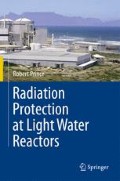Abstract
A personnel dosimetry program includes those activities associated with the measurement, monitoring and assessment of worker exposures, and retention of related exposure records. The personnel dosimetry program also serves a vital function in maintaining documentation to demonstrate that individual exposures are in compliance with regulatory exposure limits. Personnel dosimetry programs include those aspects associated with the monitoring and evaluation of personnel exposures at LWR facilities. These programs include whole-body monitoring, the use of extremity dosimeters and multiple dosimeters (often referred to as “multi-badging”), provisions for neutron dosimetry and bioassay processes for the assessment of internal exposures. This chapter discusses the various elements commonly associated with such a program. The focus is oriented towards the operational and maintenance aspects of a LWR personnel dosimetry program. Details associated with the theory and principal of detection of dosimetry devices is presented in a level of detail necessary to evaluate the application of a specific dosimeter to a LWR dosimetry program. The use, advantages and limitations of dosimeters as they apply to a LWR personnel dosimetry program are also discussed. The references for this chapter provide more detailed information concerning the detection and operational principles of the dosimeter types presented.
Access this chapter
Tax calculation will be finalised at checkout
Purchases are for personal use only
Notes
- 1.
Activity medium aerodynamic diameter simply means that 50% of the particles composing the airborne activity are smaller than the stipulated AMAD value and 50% of the particles are larger than the stipulated AMAD.
Bibliography
American National Standard ANSI/HPS N13.32, Performance Testing of Extremity Dosimeters, 1995
American National Standard ANSI/HPS N13.39, Design of Internal Dosimetry Programs, 2001
American National Standard ANSI/HPS N13.41, Criteria for Performing Multiple Dosimetry, 1997
Auman L., et al. An Intercomparison of Neutron Dosimeters and Detectors for In-Containment Dosimetry, Health Physics, 62(2):190–193, 1992
Clarke R., and Valentin J., A History of the International Commission on Radiological Protection, Health Physics, 88(5):407–422, 2005
Electric Power Research Institute, Assessment of the Effective Dose Equivalent for External Photon Radiation Volume 1: Calculational Results for Beam and Point Source Geometries, TR-101909, College Station, TX, 1993
Electric Power Research Institute, Assessment of the Effective Dose Equivalent for External Photon Radiation Volume 2: Calculational Techniques for Estimating External Effective Dose Equivalent from Dosimeter Readings, TR-101909, College Station, TX, 1995
Electric Power Research Institute, Criteria and Methods for Estimating External Effective Dose Equivalent from Personnel Monitoring Results, EDE implementation Guide, TR-109446. Palo Alto, Ac, 1998
Glickstein S., Analytical Modeling of Thermoluminescent Albedo Detectors for Neutron Dosimetry, Health Physics, 44(2):103–114, 1983
International Atomic Energy Agency, Safety Guide No. RS-G-1.2, Assessment of Occupational Exposure Due to Intakes of Radionuclides, Vienna, 1999
International Commission of Radiological Protection, 1994, Dose Coefficients for Intakes of Radionulcides by Workers, ICRP Publication 68, Pergamon Press, Oxford
International Commission of Radiological Protection, 2007 Recommendations of the International Commission on Radiological Protection, ICRP Publication 103, Pergamon Press, Oxford
International Commission on Radiological Protection, 1979, Limits for Intakes by Workers, ICRP Publication 30, Part 1, Pergamon Press, Oxford
International Commission on Radiological Protection, 1990 Recommendations of the International Commission on Radiological Protection, ICRP Publication 60, Pergamon Press, Oxford
International Commission on Radiological Protection, Annals of the ICRP 1977, ICRP Publication 26, Pergamon Press, Oxford
International Commission on Radiological Protection, Individual Monitoring for Intakes of Radionuclides by Workers: Design and Interpretation, ICRP Publication 54, Pergamon Press, New York, 1987
Leggett R., and Eckerman K., Dosimetric Significance of the ICRP’s Updated Guidance and Models, 1989-2003, and Implications for U.S. Federal Guidance, Oak Ridge National Laboratory Report ORNL/TM-2003/207, Oak Ridge, Tennessee, 2003
National Council on Radiation Protection and Measurements, Deposition, Retention and Dosimetry of Inhaled Radioactive Substances, NCRP Report No. 125, Bethesda, MD, 1997
National Council on Radiation Protection and Measurements, Dose Control at Nuclear Power Plants, NCRP Report No. 120, Bethesda, MD, 1994
National Council on Radiation Protection and Measurements, Limitation of Exposure to Ionizing Radiation, NCRP Report No. 116, Bethesda, MD, 1993
National Council on Radiation Protection and Measurements, Use of Personnel Monitors to Estimate Effective Dose Equivalent and Effective Dose to Workers for External Exposure to Low-LET Radiation, NCRP Report No. 122, Bethesda, MD, 1995
National Institute of Standards and Testing, National Voluntary Laboratory Accreditation Program, NIST Handbook 150-2D, Calibration Laboratories, Technical Guide for Ionizing Radiation Measurements, 2004
National Institute of Standards and Testing, National Voluntary Laboratory Accreditation Program, NIST Handbook 150-4, Ionizing Radiation Dosimetry, 2005
Swaja R., and Sims C., Neutron Personnel Dosimetry Intercomparison Studies at the Oak Ridge National Laboratory, Health Physics, 55(3):549–564, 1988
U.S. Nuclear Regulatory Commission, Regulatory Guide 8.26, Applications of Bioassay for Fission and Activation Products, September 1980
U.S. Nuclear Regulatory Commission, Regulatory Guide 8.32, Criteria for Establishing a Tritium Bioassay Program, July 1988
U.S. Nuclear Regulatory Commission, Regulatory Guide 8.34, Monitoring Criteria and Methods to Calculate Occupational Radiation Doses, July 1992
U.S. Nuclear Regulatory Commission, Regulatory Guide 8.40, Methods for Measuring Effective Dose Equivalent from External Exposure, July 2010
U.S. Nuclear Regulatory Commission, Regulatory Guide 8.7, Instructions for Recording and Reporting Occupational Radiation Dose Data, Revision 2, November 2005
U.S. Nuclear Regulatory Commission, Regulatory Guide 8.9, Acceptable Concepts, Models, Equations, and Assumptions for a Bioassay Program, Revision 1, July 1993
U.S. Nuclear Regulatory Commission, NRC Regulatory Issue Summary 2003-04, Use of the Effective Dose Equivalent in Place of the Deep Dose Equivalent in Dose Assessments, February 2003
U.S. Nuclear Regulatory Commission, NRC Regulatory Issue Summary 2004-01, Method for Estimating Effective Dose Equivalent from External Radiation Sources Using Two Dosimeters, February 2004
Yigal S. Horowitz, Thermoluminescence and Thermoluminescent Dosimetry, Volume 1, CRC Press, Boca Raton, Florida, 1984
Author information
Authors and Affiliations
Rights and permissions
Copyright information
© 2012 Springer-Verlag Berlin Heidelberg
About this chapter
Cite this chapter
Prince, R. (2012). Personnel Dosimetry (Monitoring of Personnel Exposures and Bioassay Programs). In: Radiation Protection at Light Water Reactors. Springer, Berlin, Heidelberg. https://doi.org/10.1007/978-3-642-28388-8_10
Download citation
DOI: https://doi.org/10.1007/978-3-642-28388-8_10
Published:
Publisher Name: Springer, Berlin, Heidelberg
Print ISBN: 978-3-642-28387-1
Online ISBN: 978-3-642-28388-8
eBook Packages: Physics and AstronomyPhysics and Astronomy (R0)

